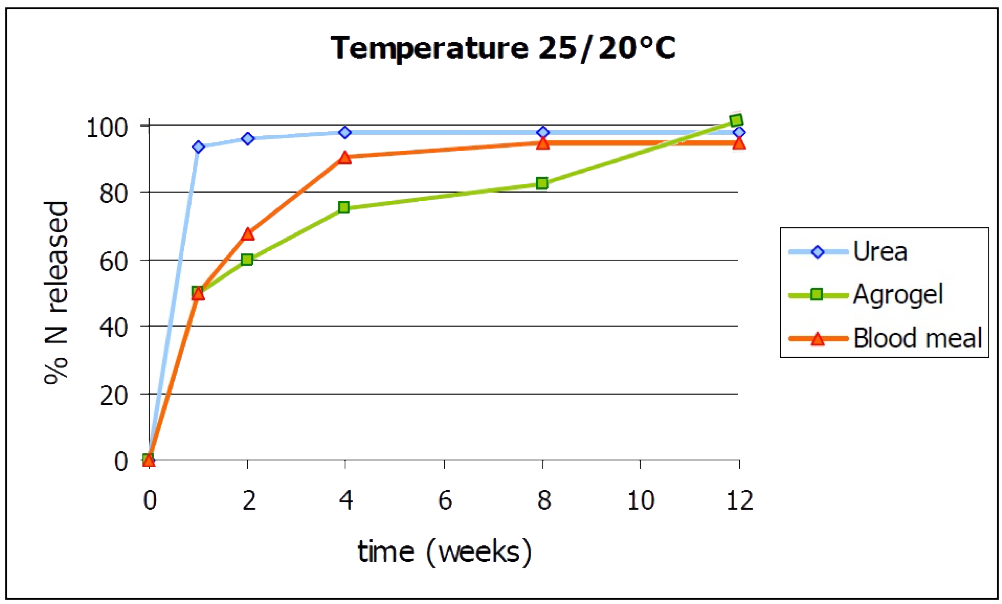Editorials
AGROGEL® high efficiency and agronomic effectiveness thanks to the slow natural release
20/12/2024
We often say that the ILSA organic fertilisers based on AGROGEL® are characterised by a high efficiency and agronomic effectiveness linked to the slow natural release of nitrogen. But how does this happen and how does ILSA manage to measure these controlled nitrogen release processes?
The studies conducted have shown that it is the activity of the microorganisms present in the soil that determines the controlled release of the nitrogen in AGROGEL®-based products. Moreover, thanks to the study of mineralisation kinetics, ILSA is able to monitor the transformation of the organic nitrogen in the fertilisers containing AGROGEL®, into nitrogen forms which can then be used by plants.
What are mineralisation curves?
Mineralisation curves show the quantity of mineral nitrogen, in the form of NO3 and NH4+, released by a fertiliser in the soil due to the bacteria mineralisation processes. This amount is expressed in ppm (parts per million), mg/kg of soil or percentage of nitrogen administered with the fertiliser under study. They therefore detail the intensity with which nitrogen fertilisers are degraded by oxidation and, consequently, the rate at which nitrogen is made available to plants.
ILSA generally adopts cumulative mineralisation curves, i.e. at each measurement interval, all the nitrogen released from the beginning of the process is added up. This enables continuously representing the progress of the degradation of the fertiliser over time.
The various studies conducted have shown that the microorganism activity is influenced by several factors, among which soil temperature is very important: the optimal range for the mineralisation process is 25-30 °C; when temperatures are low, the bacteria’s activity slows down considerably or is blocked. It has been shown instead that soil moisture does not play a fundamental role in the activity of microorganisms; as long as we do not exceed values such as to lead to an asphyxial soil, it does not change the mineralisation kinetics of the various fertilisers in an incisive manner.

Fig. 1 - Mineralisation curves in soils fertilised with Fertorganico and Fertil and incubated respectively at 5 and 23 °C

Fig. 2 - Effect of humidity (calculated as 50-70 and 90% of the field capacity) in the release of nitrogen for four different sources of organic nitrogen: alfalfa pellets, urea, blood meal and chicken manure
The studies conducted have also shown that although the released quantities of nitrogen and the release time vary, kinetics is repeated in a characteristic way for each type of fertiliser, as it depends on the matrix which constitutes it and on the industrial process.
This is why organic fertilisers are not all the same: for example, organic fertilisers, all of animal origin, have different kinetics depending on the industrial process and their matrix of origin (Fig. 3).

Fig. 3 - Mineralisation curves of various organic fertilisers of animal origin
The same occurs if we look at the mineralisation curves of AGROGEL®-based fertilisers, compared with an organic fertiliser of animal origin (blood meal) or a mineral fertiliser (urea), we immediately notice the different fate of the fertilisers in the soil: while the nitrogen from AGROGEL® is released in 12 weeks, under laboratory conditions (constant humidity and temperature), that of urea and blood meal is released respectively in one and four weeks (Fig. 4).

Fig. 4 - Mineralisation curves of AGROGEL®, urea and blood meal
In conclusion, mineralisation kinetics maps the degradation processes of nitrogen mediated by the activity of soil microorganisms, and demonstrates the ability of AGROGEL® to guarantee:
- High agronomic effectiveness since all the nitrogen it contains, as well as the carbon, is available to the soil-plant system and therefore is able to allow an optimal development even of the most demanding crops such as corn, apple trees, pear trees;
- High fertilisation efficiency as the nitrogen it contains is released progressively in relation to the request of the entire soil-plant system, thus allowing a reduction in the quantities distributed but also in the number of distribution operations.
NOTE: The ILSA method for mineralisation curves is based on an optimisation of the Stanford and Smith method of 1972 ([9]), readapted by Benedetti in 1983 ([10]), developed by Prof Cavani of the Department of Agricultural Chemistry of the Faculty of Agriculture of Bologna.





.png)
















